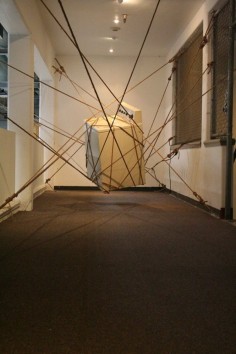CAMILO ONTIVEROS
source: madeinla2012
Interested in the transformation of objects and ideas as they move through and across nations, jurisdictions, and economies, Camilo Ontiveros (b. 1978 Rosario, Sinaloa, Mexico) has developed a practice that mines and unveils the complexities and implications of transnational laws, migration, and exchanges between the United States and Mexico. His project for Made in L.A., El Pedón (2012), takes as its point of departure federal regulations that allow for the transport of soil from foreign countries into the United States for cultural, religious, or research purposes. Ontiveros aimed to transport a one-meter cube of soil from Nayarit, Mexico, to the Hammer Museum by classifying it as an artwork or cultural object. Working with institutions in Mexico, transport companies, and U.S. and Mexican customs, the museum attempted to transport the piece to Los Angeles, but customs officials refused to allow its importation, citing the danger of introducing “foreign organisms.” Presented here is the absence of the soil cube on a wooden pedestal accompanied by a printed booklet that documents the process of sculpting the work via application forms, correspondence, and bureaucratic procedures. Two accompanying photographs and a video document the extraction, the last part of this sculptural process that was completed before the work was forced to assume its current form.
.
.
.
.
.
.
.
source: artdaily
Camilo Ontiveros (Mexico, 1978) is a conceptual artist whose work has always reflected his interest in sociopolitical themes, especially those relevant to his own life, such as issues inherent to the city of Los Angeles: immigration, power relations, underground economies, recycling and the value of the objects in a consumerist society. In his most recent projects, the documentation of his investigations through the use of documents and videos has become the central, aesthetic and conceptual element of his work.
.
.
.
.
.
.
.
source: artltdmag
His earliest work consisted of guerilla-style public interventions, often collaborative, revolving around issues pertaining to the border. In one project, he arranged all the food he could gather in a night of dumpster diving on a nicely dressed table on a lawn of the UCSD campus, then surrounded the table with a barbed wire fence and left it there for fifteen days–a spectacle of squandered abundance. In another, he illicitly altered the notorious fleeing family signs that are posted on San Diego freeways, replacing the word “Caution” with phrases like “Free Market,” “No Benefits,” and “Wanted.”
.
.
.
.
.
.
.
source: laimyours
Ontiveros’ work sees clusters of washing machines and bound mattresses and stacked, about-to-topple objects from our everyday lives. Visually, they are arresting and a bit staggering, points of concern in execution and balance: should you be viewing these pieces this close as they may fall over? How is this accomplished? Is it safe to have a mattress bound so tightly? These questions are just at the surface of Ontiveros’ work, as they are visually magnificent.
What lies beneath them is the reference, where we’ve seen these tied up items and stacked belongings before: in the beds of trucks and in neighborhoods associated with recent immigrants. His sculptures of these objects are pieces that represent these persons who literally pack up their entire life into the back of a truck and move from one place to another, one country to another country, in the hope of starting a life, which–of course–requires those objects. Outside of that, Ontiveros’ work has expressed this in other ways. I Want Your Washing Machine saw him assemble a gallery full of washing machines of various styles and ability, representing class and race, technology and design. CAUTION sees him reappropriating the Mexican-American border caution sign of a family crossing the border by placing it in different settings (like the National Museum of Mexican Art) to changing the text from “CAUTION” to “NO BENEFITS” and “FREE MARKET” and “CASH ONLY.”
.
.
.
.
.
.
.
source: entrevistasramoncarrillo
Este artista mexicano se ha convertido en punta de lanza del arte que se nutre de las divergencias de la frontera. Su obra se vende en San Diego, y desde ahí impulsa proyectos artísticos en Tijuana.


